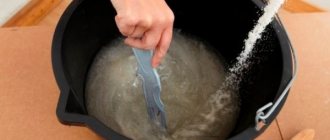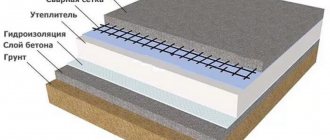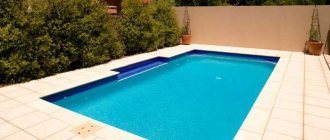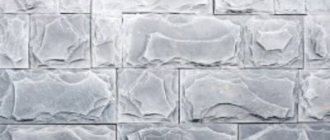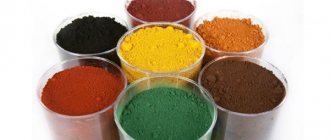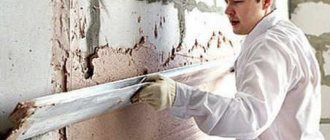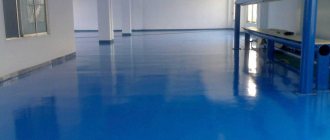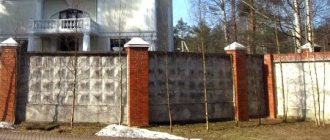A concrete platform adjacent to a house, garage, any building, as well as one built separately (for example, in a recreation area) can be decorated in such a way that it will be difficult to suspect that it is made of concrete.
One of the options for such processing of concrete is painting it, or better yet, etching it with an acid dye. To paint concrete, you can use different paints, including acrylic, polyurethane, epoxy, but they all tightly cover the surface - you can immediately see that this is painted concrete, not stone. And the acid dye gives color, depth, and color heterogeneity - everything, like in a real stone.
Painting concrete to look like stone
Modern fashion trends are widely visible not only in the construction of houses, but also in their decoration. So recently, stone-like painting has become very popular. At the same time, you can paint not only decorative stamped concrete, but also the most common building concrete.
Recently, painting to look like stone has become popular. Decorative stamped and most ordinary concrete can be painted.
You don't need to be a wizard to turn your house into a stone one. All you have to do is pick up a brush or roller and use the tips offered by experts.
In the same way you can decorate the fence and garden path. You can do this yourself.
Materials and tools
In order for painting to go quickly and successfully, you must first prepare the tools required for the job. These include:
- sandpaper;
- rubberized sponge;
- cotton rag;
- spray gun;
- file for grinding;
- degreasing solution;
- brush;
- dye;
- compressor;
- suspension for impregnation.
This decorative coating is often used to decorate landscapes or for finishing houses. Therefore, you need to carefully choose paint.
Painting concrete: how best to do it when making garden products
Painting concrete is a very important stage for DIYers, and many of them want to learn how to beautifully and reliably paint a self-made concrete figurine, flower vase, decorative stone (short video) and other garden products.
The issue of painting concrete products was partially discussed on the pages of kamsaddeco.com in the manufacture of a two-color flowerpot (short video) and a small vase for a fountain.
Once again, it should be noted that painting concrete (short video) and concrete products is mainly carried out in three ways: introducing a colored pigment into a dry concrete mixture, painting the finished product, and combining the two previous methods.
First method: painting concrete by introducing a colored pigment into a dry concrete mixture
In this case, mineral pigments are usually used, which are oxides or salts of various metals.
For paving slabs and decorative stones on paths, inexpensive iron oxide pigments (FeO, Fe2O3, Fe3O4, etc.) are mainly used, having brown, black, red and yellow colors.
There are organic pigments and dyes (for example, aniline), but they are less resistant to ultraviolet radiation and alkali in concrete. Their advantage is that they give the product a more intense color with low dye consumption.
Since for homemade ones the most important criterion (when making concrete decor) is the minimum cost of the product, we will dwell in more detail on the use of iron oxide pigments.
Iron oxide pigments for concrete
Pigment manufacturers recommend not to exceed a dosage of more than 5%. A larger amount of introduced pigment will lead to a significant deterioration in the characteristics of concrete; it becomes less durable.
To make paving slabs last longer, 2-3% of the pigment by weight of cement is added to the solution. At the same time, it is difficult to obtain a bright color of the product and usually tiles, curbstones, and paving stones have a pale color tint.
Before introducing the pigment into the concrete solution, experts in the production of paving slabs recommend diluting it in a 1:1 ratio and leaving the pigment in a deep penetration primer (such as Ceresit) for 2 hours. There are now a very large number of primers, the choice is up to the master.
In their opinion, this makes it possible to obtain a more uniform color of the product.
In some cases, for example, when using black soot as a pigment, it is necessary to dilute it in the primer, since otherwise, due to its low weight, the soot will float in the concrete solution. If you add it without diluting it into a dry mixture, as many do with iron oxide pigments, then when stirred, the soot becomes very dusty and flies through the air.
But the master may also be faced with another task - uneven coloring of concrete. It is necessary in the manufacture of artificial stone, similar, for example, to marble.
Paint coating technology
The application technology depends on the chosen painting method. A common case will be to apply one layer, but with increased requirements the number of layers increases. Painting is carried out only after the previous layer has dried.
It is also taken into account that a high-quality coating depends on the preparation of the varnish itself. Two-component paints will require mixing by mechanical means. Thickening is accompanied by the addition of solvents.
How to make it yourself
Creating a coating with your own hands consists of several stages:
- preparation of tools and equipment;
- you will need to start from the far corners;
- when applying layers, do not allow gaps, and also monitor uniformity;
- when bubbles appear, apply a roller with slight pressure;
- After completion of the work, the integrity of the coating is checked, all defects in the layers are eliminated immediately.
When applied independently, all standard safety requirements are observed, since a number of materials have increased toxicity.
How to properly plaster an OSB board indoors and on the facade
Technology of using plaster for finishing penoplex
Making dye for concrete and methods of coloring
Plastering aerated concrete walls indoors
Source
Stone impregnation
Make sure the surface of the stone is clean and dry. You can start hydrophobic impregnation.
Impregnation of artificial stone prevents chipping, protects against excessive moisture, premature abrasion, closes pores and strengthens the structure of the stone. Without soaking, the paint will lie unevenly, with “camouflage” spots, and its consumption will also increase significantly.
Hydrophobic compounds come in different forms. It is better to select the most suitable composition for your stone model, for example, choose latex impregnation.
Impregnate the stone at least twice, in as uniform a layer as possible, using brushes, a roller, a sponge or a spray gun for this purpose. After processing, while any of the layers dry, do not allow water to come into contact with the stone.
Paint selection
Artificial stone is painted with water-based silicone, acrylic and silicate paints for exterior use. They are resistant to any damage and destructive factors.
To create the desired atmosphere in the interior, designers use various materials. These include gypsum. It is great for finishing work. Powdered gypsum is diluted in water and given the desired shape. It is highly regarded in the construction world.
The most popular technology is considered to be one that can be used to create decorative bricks from gypsum. It looks like a facing tile made of brick. It is easily mounted and assembled on the wall in the form of a puzzle.
Gypsum brick tiles are painted with the following substances:
- water-based paint;
- impregnation for concrete products;
- water-soluble varnish;
- icing.
Preparatory work
Before painting, it is necessary to prepare the concrete surface so that the pigment layer lies evenly and does not peel off. The order is:
- Fill cracks and crevices with cement mortar.
- Carefully run a broom over the concrete to remove debris and dust, then pour water on it, preferably from a hose under strong pressure.
- Remove stubborn stains with a metal bristle brush, use a chemical solvent if necessary, and then wash alternately with soap and clean water.
- Wait for the concrete to dry completely after cleaning.
- Fence the area outside the treated area with oilcloth, plywood or plastic shields.
- Prime the cleaned surface to reduce pigment absorption and increase its adhesion to concrete.
- After polymerization of the primer, paint and varnish compositions are applied.
Benefits of painting
Painting the fence will make it colorful and attractive, highlight the elements and shape of the slab, highlight the seams and give harmony along the entire perimeter. The photo shows an example of painting a Euro fence, combining the shapes of concrete slabs and an option for combining different color characteristics.
Professional painters have the ability to create attractive paint options that add style and a pop of color to your yard. The façade paint is applied deeply so that the slabs completely absorb the required color.
Are you wondering how to paint a European fence? Tinting with one color or a skillful combination of several colors when painting a fence is always appropriate, fashionable and relevant.
Option for painting the Euro fence
The first impression of your home begins with the fence, so its appearance attracts attention. The fence serves as decoration of the yard and protection of your property. Painting to look like stone or decorated rubble looks great. Small shapes and a variety of slabs create stunning landscape design and emphasize the good taste of the owner.
A cheap and reliable way to transform garden paths using iron sulfate
Gray concrete paths in the garden often irritate their owners; they want to do something with them, for example, paint them in the colors of natural stone, and on a budget and so that after a couple of years the paint does not start to fall off in pieces.
Here is the recipe offered by FORUMHOUSE member Nikolai Ivanovich, Garkusha. He paints the concrete with iron sulfate, and after drying the concrete is difficult to distinguish from natural stone. The only thing: you only need to paint fresh, three-day-old concrete.
The dyeing process is not complicated. A 250-gram packet of iron sulfate is diluted in a bucket of water (if we are talking about small volumes, then 1.5 tablespoons of sulfate per liter of water).
The solution is stirred until the vitriol is completely dissolved in water, after which you can take a brush and start painting.
At first, the color of the concrete will not change at all, but after a while it will turn green.
This should not be scary - when it dries, the concrete will become grayish-yellow, like cobblestone.
On FORUMHOUSE you can learn the exciting story of Nikolay Garkusha’s self-built house, read an article on how to make self-mixed concrete, watch a video on how to make interior partitions from gas silicate blocks yourself.
Original options for creating a decorative layer on a plaster product
You can show your creative talents by painting artificial stone.
Old marble effect coating
The technique of applying CM under old marble consists of the following steps:
- before painting gypsum tiles to look like stone with the effect of old marble, gypsum cladding is purchased;
- the material is kept in a room without lighting for 2 days;
- drying oil is used in a heated state, hands are protected with rubber gloves;
- The tiles are coated in 2 layers with hot drying oil using a flat brush. The layer is applied evenly, without missing areas;
- On a plaster tile, the drying oil dries and the colored veins are emphasized. They create an imitation of old marble. Most often, such decor is found in the kitchen, on fireplaces.
Imitation terracotta
Two substances are necessary to imitate terracotta: rosin, shellac varnish material. They dissolve in technical alcohol. The result of the action will be a composition that is applied to the ingots many times. The plaster decor is drying. Only when the coating dries does the desired terracotta effect appear.
Bronze cast on tiles
A bronze cast on the finishing surface can be easily created with your own hands:
- hot drying oil is applied to the gypsum surface;
- the coating dries in 10 hours;
- Bronze powder is mixed with varnish. Gypsum is processed with the mixture at least twice;
- the new coating dries;
- prepare an acetic solution: liquid - 300 g, acetic acid - 100 ml, silver nitrate - 10 g;
- dry bronze powder is applied to the dried stones, and a vinegar solution is coated on top. On the top layer of the gypsum surface, an oxidation process occurs;
- the treated areas are wiped with a velvet cloth.
Tip: wax dissolved in turpentine and applied to finished plaster products enhances the decorative effect. Liquid wax is absorbed into the plaster. Artificial tiles are treated with the solution until it stops penetrating into the plaster. The treated surface will not be afraid of liquids.
Stain treatment
A beautiful coating is formed by stain on a gypsum surface. The material for painting is applied by spray. For a more effective result, it is recommended to dip the plaster product in a hot stain solution for only 10 seconds. The brown coating becomes a substitute on the dried surface of the cladding.
